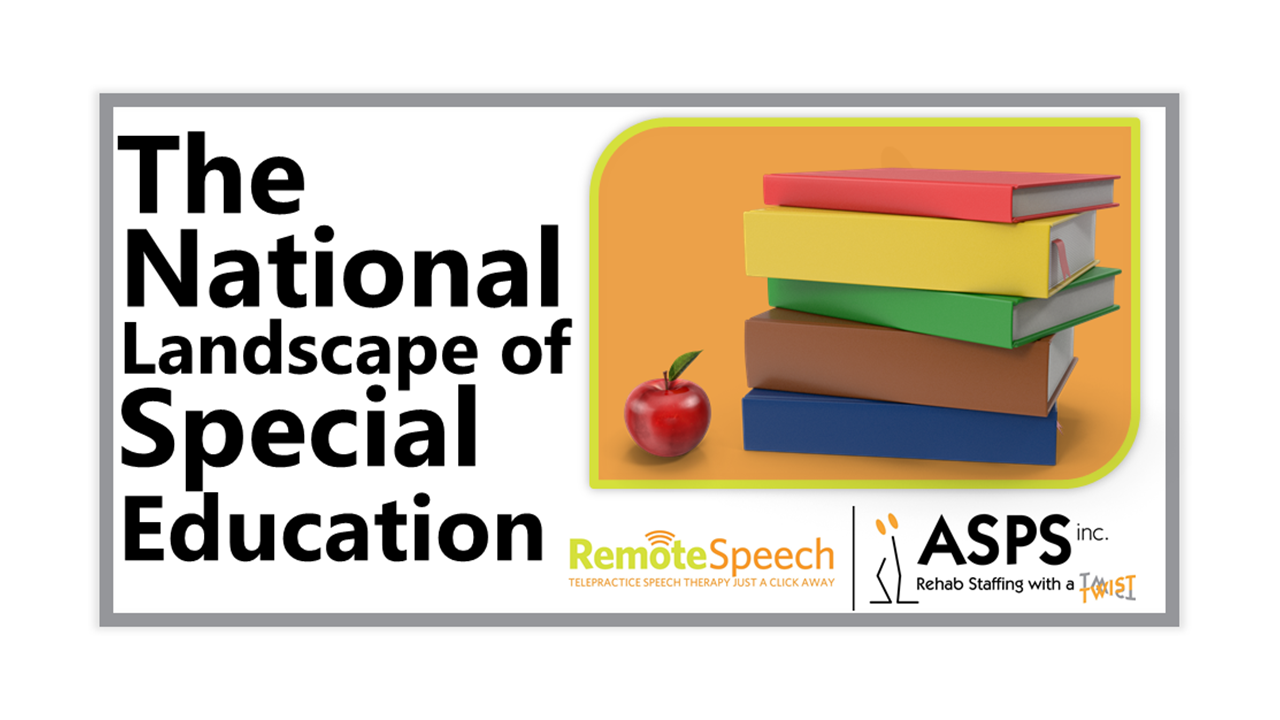
09
Jul
The National Landscape of Special Education
While we normally associate summer months with children taking a break in their education, the same can not be said of school administration. For the latter, there are no breaks for administrators that carry the district’s challenges with them in their passionate service. Administrators who carry the specific and unique challenges of their own district are recently experiencing trends that are experienced cross-country on a national scale, and that are steadily increasing. While the severity of these shared challenges might vary by region, they all include realities that district administrators are familiar with and have experienced at some point in their careers. Further, problems may change considerably depending on who is labeling them, whether it is students, parents, educators, or lawmakers.
So what are these common realities? And, how do these realities contribute to servicing special education programs?
We've drafted a list of the top realities of Public schools across the country, based on the perspective of many involved in the world of education today.
 Sources:
American Speech-Language-Hearing Association. (2018). 2018 Schools Survey report: SLP workforce/work conditions.
2 American Speech-Language-Hearing Association. (2018).
2018 Schools Survey summary report: Numbers and types of responses, educational audiologists.
3 National Association of School Psychologists
4 American School Counseling Association
5 National Association of School Nurses
6 Zhang, J. (2011). Quantitative analyses about market-and prevalence-based needs for adapted physical education teachers in the public schools in the United States. The Physical Educator, 68(3), 140–150.
7 Fischgrund, J. , & Tucker, J. , 2017, Future Needs at CEASD Schools for the Deaf. CEASD Annual Conference, St. Augustine, FL
8 2011 – 2012 Special Education/Related Services Personnel Shortages List
9 Budget Cuts Threaten Special Education Services
Sources:
American Speech-Language-Hearing Association. (2018). 2018 Schools Survey report: SLP workforce/work conditions.
2 American Speech-Language-Hearing Association. (2018).
2018 Schools Survey summary report: Numbers and types of responses, educational audiologists.
3 National Association of School Psychologists
4 American School Counseling Association
5 National Association of School Nurses
6 Zhang, J. (2011). Quantitative analyses about market-and prevalence-based needs for adapted physical education teachers in the public schools in the United States. The Physical Educator, 68(3), 140–150.
7 Fischgrund, J. , & Tucker, J. , 2017, Future Needs at CEASD Schools for the Deaf. CEASD Annual Conference, St. Augustine, FL
8 2011 – 2012 Special Education/Related Services Personnel Shortages List
9 Budget Cuts Threaten Special Education Services
1.SHORTAGE OF QUALIFIED SERVICE PROFESSIONALS
Personnel shortages are the result of recruitment and retention challenges. There is both a shortage of professionals to fill available positions and a shortage of positions to meet the growing demand for services for America’s six million children and youth with disabilities who receive special education services. According to the National Coalition on Personnel Shortages in Special education and related services,:- 54% of speech-language pathologists (SLPs) report shortages in their schools. SLPs from the western region of the United States (mountain and pacific states) are most likely to report shortages.1
- Overall, 15% of educational audiologists report shortages in their schools.2
- The national ratio of school psychologists (1:1182) is twice the recommended ratio (1:500–700). Further, there will be a shortage of almost 15,000 school psychologists in the United States by 2020.3
- The national ratio of students to school counselors (482:1) is almost twice the recommended ratio (250:1).4
- National data indicate 39% of public schools have a school nurse all day, every day, while another 35% of schools have a school nurse who works part-time in one or more schools. Twenty-five percent of schools do not employ a school nurse.5
- National data indicate a critical 76% shortfall in the number of certified adapted physical education (APE) teachers needed within the United States, with an estimated 20,087 additional APE teachers needed.6
- A recent survey performed only among schools for the deaf anticipates a demand for at least 500 teachers of the deaf in these schools over the next three years. However, the majority of deaf and hard of hearing students attend school in the mainstream, therefore this number greatly underestimates the number needed.7
- 49 states report a shortage of special education teachers/related service personnel for 2013–2014.8
- 82% of special educators and SISP from across the nation report that there are not enough professionals to meet the needs of students with disabilities.9
2. A STEADY INCREASE IN THE NEED FOR SPECIAL EDUCATION SERVICES.
There has been a growing increase in the number of students that require school therapy services. This increase could be seen in special education, speech, occupational therapy, physical therapy, or counseling. Consequently, the increase in demand has led to an increase in The number of students enrolled in special education programs. Consider the following:- Over the past decade, the number of students in the United States enrolled in special education programs has risen 30 percent, according to the National Education Association (NEA).
- Nearly six million students with disabilities attend public schools in the U.S., reports the Education Week Research Center.
- Students receiving special education services under the Individuals with Disabilities Education Act (IDEA), Part B, make up roughly 9 percent of all six-to-21-year-olds.
- three out of every four students with disabilities spend at least 40 percent of their school day in regular classrooms, alongside peers without disabilities, according to NEA. The result is an increased need for teachers trained to face the additional challenges of teaching students with a wide variety of disabilities, even as general educators.
3. THE INCREASING COST OF SPECIAL EDUCATION SERVICES.
According to a report titled “The Misdiagnosis of Special Education Costs”, issued by The School Superintendent Association, Local school districts nationwide are experiencing increases in special education costs. In states that are placing a high priority on education reform, the special education cost increases are rapidly compromising the ability of districts to effectively fund the implementation of these reforms. However, in searching for a way to address rising costs, policymakers often err in their diagnosis of the problem.According to their research: “School district policy and practice was effective in containing and even reducing the percentage of children who required special education services. We found that cost increases were primarily due to the increased number of children with more significant special needs who require more costly services. The root causes of these increases were factors beyond the control of schools, such as advances in medical technology, the deinstitutionalization of children with special needs and privatization of services. Also contributing were economic and social factors, such as the rising number of children in poverty and the number of families experiencing social and economic stress.”Special education programs are not immune to the national trend of budget cuts. According to the annual report issued by the Department Of Education, the 2020 Special Education Fiscal Budget Request Report further illustrates the unique challenges faced by special education.4.BUDGET CUTS
School districts nationwide are experiencing various budget challenges – but recently, these challenges are increasingly being described as “crises.” In fact, Budget cuts have created huge problems for most public schools in recent years. Less funding means smaller staffs, fewer resources and a lower number of services for students. While some argue that throwing more money at the education problems won’t make them go away, others assert that lack of funding caused many of the problems in the first place.
5.TECHNOLOGY
Kids Health Guide reports that students are more technologically advanced than many teachers today, putting instructors at a decided disadvantage in the classroom. However, a student’s love of technology also tends to distract him from his schoolwork, according to NEA Today. When teachers don’t have the techno-savvy to compete with those devices, by bringing education and technology together, it can be difficult to keep students’ interest and attention to properly teach new concepts. Technology needs to come into the classroom to keep up with the learning demands of the 21st century. Schools that are already cash-strapped may find an unsurmountable challenge in coming up with the funding to bring computers and other forms of technology into their classes. Scholastic offers some tips for school districts that want to fit the bill for technology, including everything from asking individuals in the district for “big gifts” to going to Uncle Sam for the funding. The website also suggests negotiating prices on technology when possible and allowing student to bring their own from home. Further, school districts have turned to teletherapy to fill their vacant roles for staff shortages.6.Poverty
Technorati reported last fall that 22 percent of the children in the U.S. live at or below poverty level. American Graduate defines poverty as a family of four with an annual income level of $23,050 or lower. American Graduate also cites a report from the Southern Education Foundation, which shows in 17 states across the U.S., low-income students now comprise the majority of public school students in those states. Some estimates put poverty levels for public school students at 25% in the not-so-distant future. Students living at or below poverty level tend to have the highest dropout rates. Studies show that students who do not get enough food or sleep are less likely to perform at their full academic potential. Schools know these truths first-hand, and despite efforts to provide students with basic essentials, teachers, administrators and lawmakers know there is simply not enough to go around.7.Classroom Size
Many areas of the country are facing classrooms that are literally busting out at the seams. A report at NEA Today two years ago discussed how schools in Georgia, in the midst of major funding cuts for schools, had no choice but to lift all class size limits to accommodate students with the faculty the school system could still afford to keep. More recently, Fairfax County in Virginia has been looking into a proposal to increase classroom sizes in the face of significant budget cuts. The Board of Education in South Carolina is also weighing their options in this area. When money gets tight, classroom numbers are often impacted. Yet, most teachers agree that they cannot effectively teach every student in a classroom, if the class size exceeds about 30. Their statements are backed up by research. Class Size Matters cites a study performed by the Tennessee Star that found classes of 15-17 students in grades K-3 provided both long and short-term benefits to both the students and the teachers in those classrooms. Minority students, those living in poverty, and male students appeared to benefit from smaller classroom sizes the most.Learn More with Case Studies: How School Districts Cope with Challenges Surrounding Special Education -
Learn How School Districts Benefit from Telepractice
______________________________________________________________________________________Do you believe that your school could benefit in combatting some of these challenges, including reducing costs, addressing personnel shortages/certifications, along with meeting both State and Federal guidelines? Contact us today!!
 Sources:
American Speech-Language-Hearing Association. (2018). 2018 Schools Survey report: SLP workforce/work conditions.
2 American Speech-Language-Hearing Association. (2018).
2018 Schools Survey summary report: Numbers and types of responses, educational audiologists.
3 National Association of School Psychologists
4 American School Counseling Association
5 National Association of School Nurses
6 Zhang, J. (2011). Quantitative analyses about market-and prevalence-based needs for adapted physical education teachers in the public schools in the United States. The Physical Educator, 68(3), 140–150.
7 Fischgrund, J. , & Tucker, J. , 2017, Future Needs at CEASD Schools for the Deaf. CEASD Annual Conference, St. Augustine, FL
8 2011 – 2012 Special Education/Related Services Personnel Shortages List
9 Budget Cuts Threaten Special Education Services
Sources:
American Speech-Language-Hearing Association. (2018). 2018 Schools Survey report: SLP workforce/work conditions.
2 American Speech-Language-Hearing Association. (2018).
2018 Schools Survey summary report: Numbers and types of responses, educational audiologists.
3 National Association of School Psychologists
4 American School Counseling Association
5 National Association of School Nurses
6 Zhang, J. (2011). Quantitative analyses about market-and prevalence-based needs for adapted physical education teachers in the public schools in the United States. The Physical Educator, 68(3), 140–150.
7 Fischgrund, J. , & Tucker, J. , 2017, Future Needs at CEASD Schools for the Deaf. CEASD Annual Conference, St. Augustine, FL
8 2011 – 2012 Special Education/Related Services Personnel Shortages List
9 Budget Cuts Threaten Special Education Services





